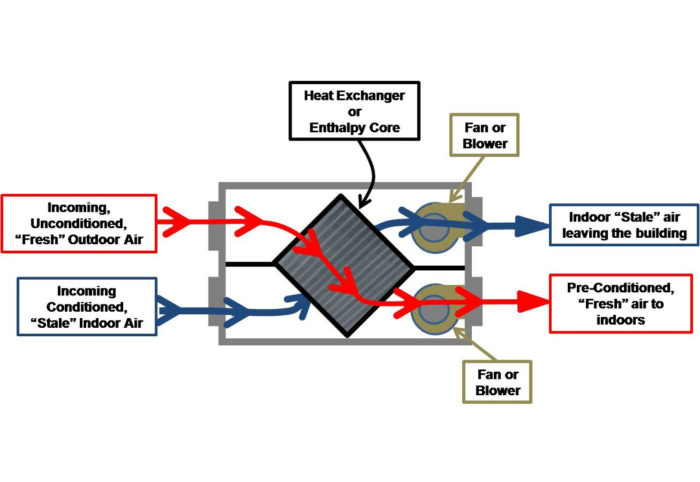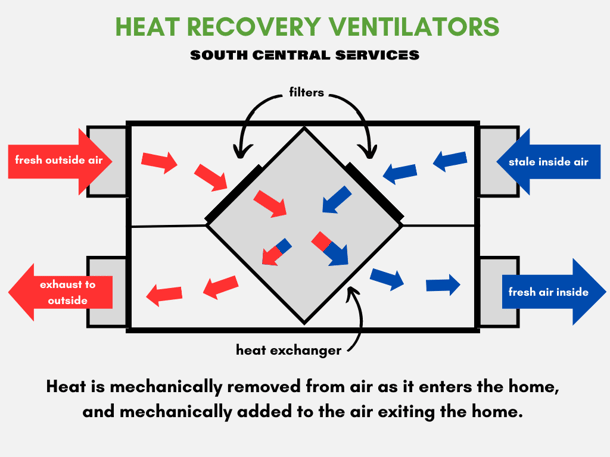Revealing the Secret Perks and Uses of Heat Recovery Ventilation in Sustainable Layout
Heat Recovery Ventilation (HRV) systems play a crucial role in sustainable layout. They promote a constant exchange of stale indoor air with fresh outside air, greatly enhancing interior air quality. In addition, HRVs add to power performance by reclaiming heat from exhausted air, which can lower utility costs. Recognizing the complex benefits and applications of HRVs discloses their value in modern-day style. What other advantages do these systems supply in the quest of sustainability?
Comprehending Heat Recovery Ventilation Systems
Heat recovery ventilation (HRV) systems are designed to enhance interior air quality while decreasing energy loss. These systems use a mechanical ventilation approach to exchange stagnant interior air with fresh outdoor air, guaranteeing a continuous supply of clean air. By capturing heat from the exhaust air, HRVs prerequisite inbound air, reducing the demand on home heating and cooling down systems. This process not just boosts thermal comfort but likewise adds to power effectiveness in property and industrial structures. Additionally, HRV systems aid manage humidity degrees and minimize interior toxins, advertising a much healthier living environment. Their critical implementation is vital for achieving sustainable style objectives, as they supply a balance between power preservation and passenger wellness.
Just How HRV Equipment Job
While many might know with air flow systems, recognizing just how warmth healing ventilation (HRV) systems run is necessary for appreciating their advantages. HRV systems work by trading stale indoor air with fresh exterior air while transferring warmth between both streams. This procedure happens in a warmth exchanger, where warm from the outgoing air heats the inbound air during cooler months, minimizing energy loss. On the other hand, in warmer months, the system can cool inbound air utilizing the cooler outward bound air. HRVs are outfitted with followers to assist in air flow and filters to get rid of particulates, making sure a constant, well balanced air flow procedure. This cutting-edge design not only improves power efficiency however likewise adds to keeping a comfy indoor atmosphere.
Enhancing Indoor Air Top Quality
Interior air high quality can considerably impact wellness and wellness, making effective ventilation important in modern homes. Heat Recovery Ventilation (HRV) systems play a vital role in preserving interior air high quality by continuously exchanging stagnant interior air with fresh exterior air. This process not only reduces air-borne contaminants but also decreases humidity levels, which can bring about mold and mildew development and respiratory system concerns. HRV systems filter incoming air, removing irritants and particulates, thus providing a healthier living setting. Furthermore, these systems help remove smells and unstable organic compounds (VOCs) generally discovered in house products. By guaranteeing a regular flow of clean air, HRV systems add to a total better indoor atmosphere, advertising convenience and wellness for passengers.
Energy Effectiveness and Price Cost Savings
Energy performance attracts attention as a significant benefit of Heat Recovery Ventilation (HRV) systems. By recording and recycling the warmth from tired indoor air, HRVs lessen the energy required for heating inbound fresh air, resulting in lowered power intake. This effectiveness converts right into reduced utility costs, supplying significant cost savings for house owners and companies alike. Additionally, HRV systems commonly get power efficiency incentives and discounts, further improving their financial charm. In time, the initial financial investment in HRV modern technology can cause a beneficial roi through decreased energy costs. Subsequently, the combination of HRV systems not only advertises sustainable style yet likewise provides a practical option for accomplishing long-lasting energy financial savings and financial benefits.
Ecological Advantages of HRV

A multitude of environmental advantages occurs from the execution of Heat Recovery Ventilation (HRV) systems. By efficiently transferring warmth from exhaust air to inbound fresh air, HRVs considerably reduce the energy needed for heating and cooling down spaces. This power efficiency translates to reduce greenhouse gas emissions, contributing to a decrease in the overall carbon impact of buildings. In addition, HRV systems improve interior air high quality by constantly flowing fresh air, thus minimizing the focus of interior toxins and allergens. The decrease in energy consumption help in conserving all-natural sources, making HRVs an important part of lasting layout. Generally, the ecological advantages of HRVs play a crucial role in advertising a much healthier earth and cultivating eco-friendly building techniques.
Versatile Applications in Modern Architecture
Heat recovery ventilation (HRV) systems are progressively being incorporated into both residential and industrial building jobs. In domestic setups, HRVs boost indoor air high quality while maximizing power efficiency. Meanwhile, in commercial rooms, these systems enhance air flow techniques, showing their adaptability in contemporary architectural applications.
Residential Projects Combination
While modern design significantly stresses sustainability, the combination of warmth recovery ventilation systems in residential projects has actually emerged as a practical option for boosting indoor HRV Heat Recovery Ventilation air quality and energy efficiency. These systems successfully transfer warm from exhaust air to inbound fresh air, reducing energy loss and decreasing heating or cooling demands. In brand-new builds and retrofits alike, heat healing air flow can be effortlessly integrated, supplying homeowners with a healthier living environment while lowering utility costs. In addition, with enhancing recognition of environmental impacts, even more engineers and building contractors are identifying the long-term benefits of these systems. Therefore, heat recovery ventilation has come to be a critical part of sustainable residential layout, showcasing convenience and dedication to eco-friendly methods.
Commercial Rooms Optimization
As modern-day business areas advance to meet the needs of sustainability and efficiency, the application of heat recuperation ventilation systems becomes a vital strategy for enhancing indoor settings. These systems facilitate the exchange of stagnant indoor air with fresh outdoor air while recovering heat power, substantially decreasing energy usage. This not just improves comfort for residents however likewise helps in reducing functional prices. Functional applications can be observed in workplaces, retail rooms, and universities, where air high quality and temperature level control are paramount. Furthermore, incorporating warm recovery ventilation lines up with environment-friendly structure certifications, even more promoting ecological responsibility. Inevitably, taking on such systems in commercial design not only adds to sustainability objectives however likewise fosters healthier, more productive areas for users.
Incorporating HRV Into Sustainable Layout Practices
Integrating warmth healing ventilation (HRV) systems into sustainable design practices supplies significant benefits in energy effectiveness and interior air high quality. By utilizing HRV, developers can create cost-efficient options that not only lower energy usage however also boost the total convenience of indoor atmospheres. This placement with sustainability goals settings HRV as a vital element in modern building strategies.
Energy Effectiveness Improvement
By incorporating warmth healing ventilation (HRV) systems right into sustainable style techniques, designers and contractors can significantly improve power effectiveness in modern building and constructions. HRV systems function by catching heat from outward bound stale air and moving it to incoming fresh air, decreasing the power needed for heating or cooling down indoor rooms. This process not just lowers reliance on traditional HVAC systems yet additionally decreases total energy usage. In enhancement, HRV systems can assist preserve a consistent interior temperature level, minimizing peak energy needs. By incorporating these systems, buildings can accomplish significant reductions in utility prices and carbon impacts, aligning with sustainability objectives. Eventually, HRV modern technology stands for a useful service for enhancing power performance in the built environment, advertising more responsible source use.
Indoor Air High Quality Renovation
How can heat recuperation air flow (HRV) systems add to premium interior air high quality in modern-day buildings? HRV systems effectively exchange stagnant indoor air with fresh outdoor air while recovering warm power, decreasing temperature level fluctuations. This process lowers the focus of indoor pollutants, such as unpredictable natural compounds (VOCs), allergens, and wetness, which can degrade air quality and effect owner health and wellness. By keeping perfect humidity degrees and making certain a continual supply of clean air, HRVs aid develop a much healthier indoor atmosphere. In addition, these systems can be integrated into sustainable layout methods, advertising energy performance alongside boosted air quality. HRV Heat Recovery Ventilation. HRV technology plays an essential function in advancing general occupant convenience and well-being in contemporary architectural designs.
Economical Layout Solutions

Regularly Asked Concerns
What Maintenance Is Required for Heat Recovery Ventilation Systems?

Maintenance for warmth recuperation ventilation systems normally includes normal filter replacements, cleaning of heat exchangers, assessment of fans and ducts, and ensuring appropriate water drainage. These tasks assist keep effectiveness and extend the system's life expectancy over time.
Can HRV Systems Be Set Up in Existing Buildings?
Heat recovery ventilation systems can without a doubt be installed in existing structures. HRV Heat Recovery Ventilation. Retrofitting calls for careful planning and assessment of the building's layout, making certain compatibility with present systems while making best use of energy effectiveness and interior air quality
Just How Do HRV Solution Impact Sound Degrees Inside Your Home?
HRV systems can influence indoor sound levels by introducing noise from exterior resources through ventilation. High-grade installments typically integrate sound-dampening features, lessening noise effect while providing reliable air exchange and maintaining convenience inside your home.
Exist Any Kind Of Downsides to Utilizing HRV Solutions?
The downsides of using HRV systems consist of prospective high first costs, upkeep obstacles, and the possibility of minimized interior air top quality if filters are sporadically changed, which could lead to problems with humidity degrees.
How Do I Choose the Right HRV System for My Needs?
Picking the best warmth healing air flow system involves examining details needs, such as developing dimension, environment, and energy effectiveness goals. Furthermore, evaluating system attributes, setup requirements, and maintenance considerations is important for peak efficiency and satisfaction.